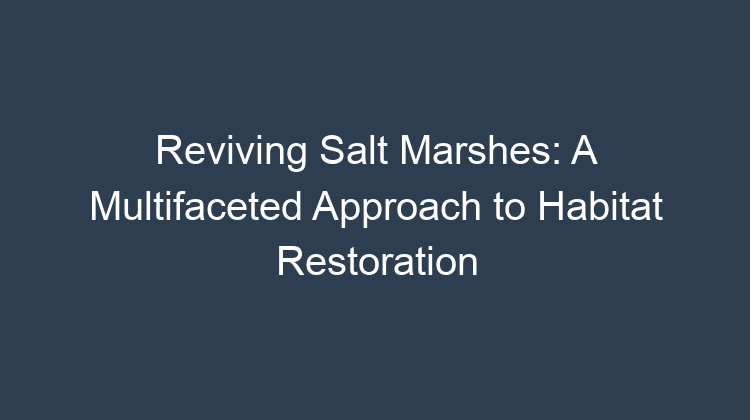Salt marshes, dynamic ecosystems at the intersection of land and sea, are invaluable natural assets. These coastal wetlands provide habitat for diverse wildlife, serve as natural buffers against storms, and filter pollutants from water. However, human activities, such as development and pollution, have degraded many salt marshes. Recognizing their significance, extensive efforts are underway to restore these vital ecosystems.
The restoration of salt marsh habitats involves a multifaceted approach, encompassing various techniques and strategies. By addressing the underlying causes of degradation and implementing targeted restoration measures, conservationists aim to revitalize these ecosystems and restore their ecological functions. The ultimate goal is to create sustainable and resilient salt marshes that can withstand future threats and provide long-term benefits to wildlife and human communities.
Restoring Hydrology and Sedimentation Patterns
Tidal Restoration: Reconnecting Salt Marshes with Tidal Flows
A crucial aspect of salt marsh restoration is reestablishing natural tidal flows. Tidal inundation is essential for maintaining the health and productivity of salt marshes. Restoring tidal flows can involve removing barriers, such as berms or dikes, that impede water flow. This allows tidal waters to inundate the marsh, replenishing sediments and nutrients, and supporting the growth of salt marsh vegetation.
Sediment Management: Addressing Erosion and Accretion
Sediment dynamics play a vital role in the health of salt marshes. Erosion can lead to marsh loss, while excessive sedimentation can smother vegetation and alter ecosystem structure. Restoration efforts often involve managing sediment dynamics to promote accretion and minimize erosion. This can be achieved through various techniques, such as sediment trapping structures, marsh terracing, and the use of sediment-stabilizing plants.
By restoring natural tidal flows and managing sediment dynamics, conservationists aim to create conditions that support the long-term sustainability of salt marshes.
Revegetation and Habitat Enhancement
Planting Native Species: Restoring Salt Marsh Vegetation
Replanting native salt marsh vegetation is a key component of restoration efforts. Native plants play a crucial role in stabilizing sediments, providing habitat for wildlife, and filtering pollutants from water. Restoration projects often involve planting salt marsh species, such as cordgrass, saltwort, and sea lavender, to reestablish a diverse and resilient plant community.
Creating Diverse Habitats: Enhancing Salt Marsh Ecosystems
Salt marshes provide habitat for a variety of wildlife, including birds, fish, and invertebrates. Enhancing habitat diversity is essential for supporting a healthy ecosystem. Restoration efforts may involve creating mudflats, tidal pools, and other microhabitats that provide diverse niches for wildlife. These habitats can be created through strategic grading, excavation, and planting of appropriate vegetation.
Controlling Invasive Species: Removing Non-Native Threats
Invasive species can pose a significant threat to salt marshes, outcompeting native vegetation and altering ecosystem structure. Controlling invasive species is a critical aspect of restoration efforts. This can involve manual removal, targeted herbicide application, and the introduction of natural predators.
Through revegetation and habitat enhancement, conservationists aim to restore the ecological integrity of salt marshes and support a thriving and diverse ecosystem.
Addressing Pollution and Water Quality Issues
Reducing Nutrient Loading: Combating Eutrophication
Excessive nutrient loading from agricultural runoff and urban wastewater can lead to eutrophication, a condition characterized by an overabundance of nutrients that can harm salt marshes. To address this issue, restoration efforts may involve implementing nutrient management practices in upstream watersheds, reducing fertilizer use, and improving wastewater treatment. These measures help to reduce nutrient inputs and mitigate the negative effects of eutrophication.
Managing Toxic Contaminants: Removing Pollutants from Salt Marshes
Salt marshes can accumulate toxic contaminants from various sources, such as industrial discharges and urban runoff. Restoring water quality is essential for the health of salt marshes and the wildlife that depend on them. Efforts may involve dredging contaminated sediments, implementing pollution control measures, and restoring natural water flows to flush out pollutants.
Monitoring and Adaptive Management: Ensuring Long-Term Success
Monitoring the progress of restoration projects is crucial for ensuring their long-term success. Regularly monitoring vegetation, wildlife populations, and water quality allows conservationists to assess the effectiveness of restoration efforts and make necessary adjustments. Adaptive management, which involves modifying restoration strategies based on monitoring results, is essential for achieving successful outcomes.
By addressing pollution and water quality issues, conservationists aim to restore the health and productivity of salt marshes, creating resilient ecosystems that can thrive in the face of ongoing environmental challenges.
FAQs
What are the main goals of salt marsh restoration projects?
The main goals of salt marsh restoration projects are to reestablish natural tidal flows, manage sediment dynamics, revegetate the marsh with native species, enhance habitat diversity, control invasive species, address pollution and water quality issues, and monitor the progress of restoration efforts.
How does restoring salt marshes benefit wildlife?
Restoring salt marshes provides habitat for a variety of wildlife, including birds, fish, and invertebrates. These ecosystems serve as breeding and nursery grounds, providing food, shelter, and protection from predators. By restoring salt marshes, conservationists help to support healthy wildlife populations and maintain the biodiversity of coastal ecosystems.
What are some of the challenges associated with restoring salt marshes?
Restoring salt marshes can be challenging due to various factors, including the availability of suitable restoration sites, the cost of restoration projects, and the need for long-term monitoring and adaptive management. Additionally, addressing the underlying causes of salt marsh degradation, such as pollution and development, can be complex and require collaboration among various stakeholders.
How can the public get involved in salt marsh restoration efforts?
The public can get involved in salt marsh restoration efforts by volunteering with local conservation organizations, supporting organizations that work to protect and restore salt marshes, educating themselves and others about the importance of salt marshes, and advocating for policies that protect these valuable ecosystems.
What are some success stories of salt marsh restoration projects?
There are numerous success stories of salt marsh restoration projects around the world. For example, the restoration of the San Francisco Bay salt marshes has resulted in a significant increase in wildlife populations and improved water quality. Additionally, the restoration of the North Carolina Outer Banks salt marshes has helped to protect coastal communities from storms and flooding.
Conclusion
Salt marshes are vital ecosystems that provide numerous benefits to wildlife and human communities. However, human activities have degraded many of these ecosystems. Restoration efforts aim to revitalize salt marshes and restore their ecological functions. By implementing a multifaceted approach that addresses the underlying causes of degradation and employs targeted restoration measures, conservationists strive to create sustainable and resilient salt marshes that can withstand future threats and continue to provide their valuable ecosystem services for generations to come.







